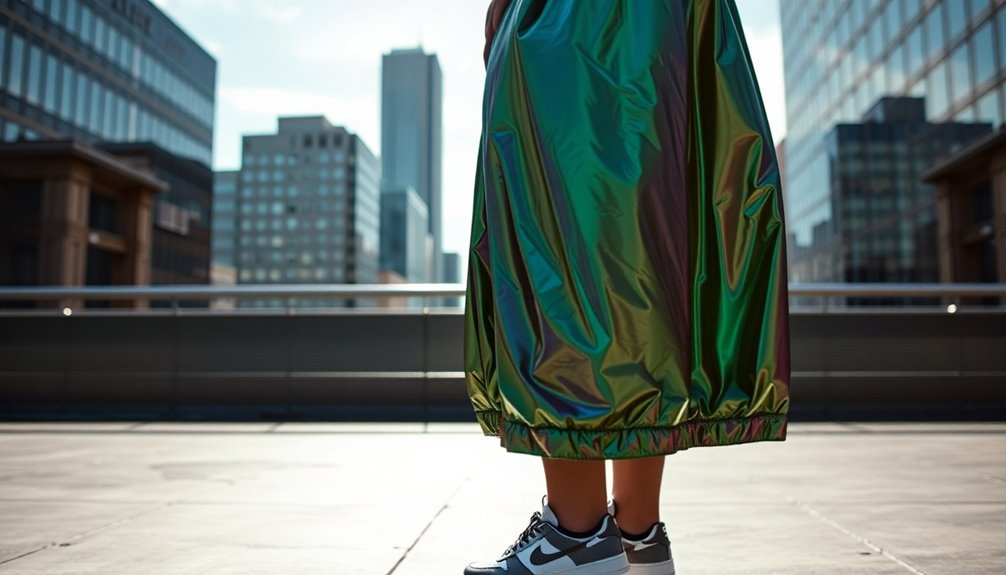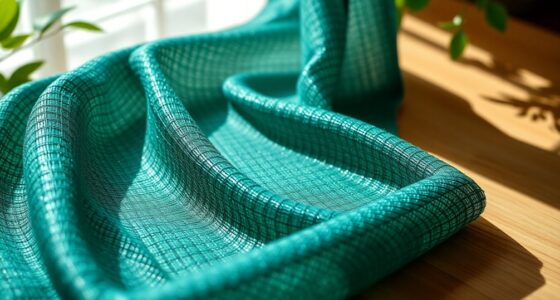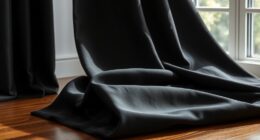Oil fabric, originally created for waterproof clothing in the late 1800s, combines style with practicality, making it a must-have in streetwear. It's durable, water-resistant, and easy to maintain, perfect for urban environments. You can find it in various colors and trendy designs, allowing you to express your unique fashion sense. Plus, with its eco-friendly production, it aligns with sustainable fashion values. Stick around, and you'll discover more about how to incorporate this versatile material into your wardrobe!
Key Takeaways
- Oil fabric, developed in the late 1800s, is a waterproof material originally created for sailors and has evolved into trendy streetwear.
- Known for its exceptional water resistance, oil fabric keeps users dry in unpredictable weather while maintaining a stylish appearance.
- Durable and easy to maintain, oil fabric garments require minimal cleaning and can be easily reproofed to enhance longevity.
- Available in various colors and styles, oil fabric allows for unique fashion statements and versatile styling options in urban environments.
- Often made from organic materials, oil fabric supports sustainable practices and eco-conscious consumer choices in the fashion industry.
The Origins of Oil Fabric
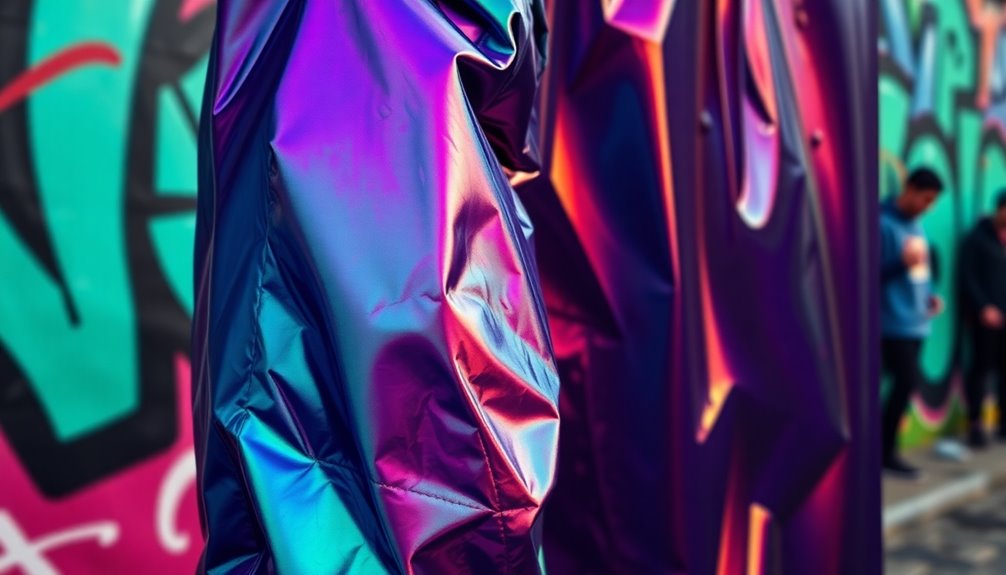
Oil fabric, or oilskin, has a fascinating history that began in the late 1800s when New Zealander sailor Edward Le Roy sought a solution for waterproof clothing to protect sailors and fishermen.
He created traditional oilskin by painting cotton fabric with linseed oil and wax, allowing it to withstand harsh sea conditions. This innovation was essential for ensuring comfort and safety at sea, enabling sailors to endure extreme weather while keeping dry.
Over time, the use of oil fabric expanded beyond maritime needs, evolving into outdoor apparel and becoming a staple in fashion.
Today, oilskin comes in various colors and styles, appealing to contemporary trends while maintaining its original purpose of providing reliable waterproof clothing.
Characteristics of Oil Fabric
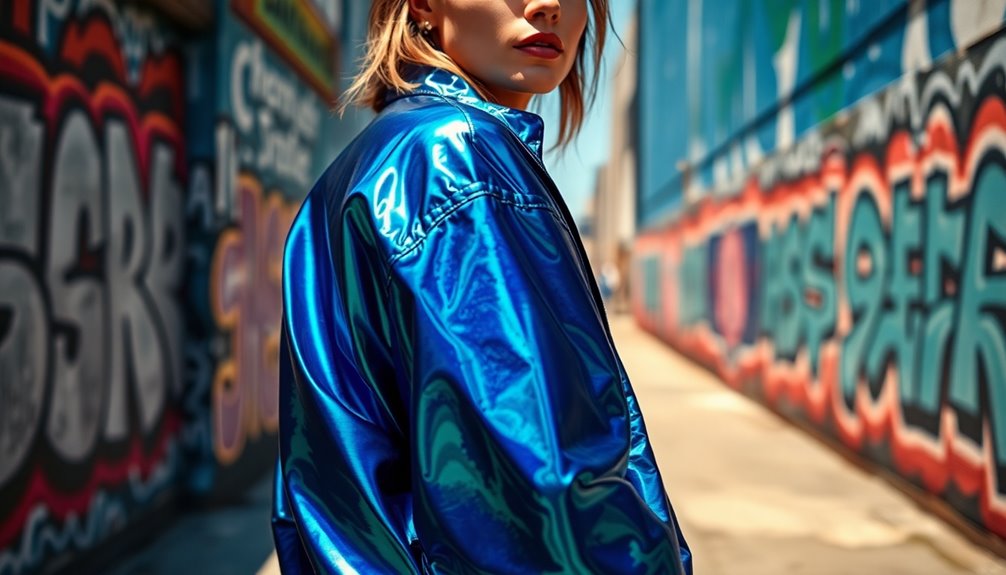
When you think about oil fabric, you'll notice its impressive water resistance that keeps you dry in wet conditions.
This durable material is also surprisingly flexible, making it easy to wear and style for various streetwear looks.
With its combination of strength and adaptability, oil fabric truly stands out in any wardrobe.
Water Resistance Properties
Many streetwear enthusiasts appreciate the exceptional water resistance of oil fabric, which makes it a top choice for unpredictable weather conditions.
This unique material, often made from cotton treated with oils and waxes, features a multi-layered waterproofing process that creates a barrier against liquid penetration. You can stay dry even in heavy rain, as oil fabric maintains its water repellency for an extended period.
However, you might need to reproof it occasionally to restore its protective qualities. Along with its impressive water resistance, oil fabric offers durability, standing up to wear and tear while remaining functional.
Plus, it's easy to clean; just wipe away mud and dirt with a damp cloth, making it perfect for your streetwear lifestyle.
Durability and Flexibility
While you might seek style in streetwear, durability and flexibility play essential roles in choosing materials like oil fabric. This fabric, especially oilskin, is renowned for its exceptional durability, making it resistant to wear and tear in various urban and outdoor settings.
Its flexibility allows designers to create comfortable, stylish pieces that guarantee mobility without sacrificing protection against the elements. With weights ranging from 169gsm to 470gsm, oil fabric can be tailored for different applications, balancing sturdy and lightweight options for easy wear.
Additionally, its water-resistant properties, derived from an oil and wax treatment, help repel moisture while enhancing longevity. Embrace oil fabric for a fashionable yet practical choice that combines durability and flexibility seamlessly.
Benefits of Using Oil Fabric in Streetwear

Oil fabric offers streetwear enthusiasts a perfect blend of style and practicality, ensuring you stay protected from unpredictable weather without sacrificing your look.
This innovative material combines cotton and oil, providing an impressive waterproof barrier that keeps you dry during rainy days. The durability of oil fabric means your garments can withstand wear and tear, making them ideal for active lifestyles in urban environments.
Plus, maintenance is a breeze—just wipe down your pieces to remove dirt and mud. With a variety of colors and styles available, you can easily find trendy options that suit your taste.
And if you ever need to restore its waterproof properties, reproofing oil fabric is simple, extending the life of your favorite streetwear pieces. Additionally, the color accuracy of oil fabric can significantly enhance the overall aesthetic appeal of your outfits, making them stand out in any urban setting.
How Oil Fabric Is Made
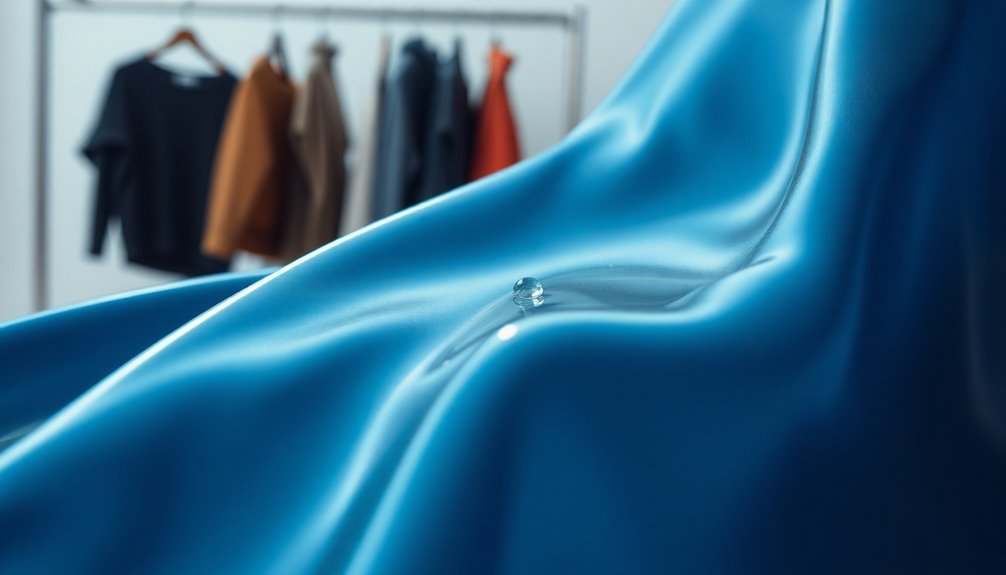
To understand how oil fabric is made, you need to look at two key processes: the oil treatment and the curing steps.
First, the base fabric gets treated with layers of oils and resins, making it water-resistant.
Then, the curing process solidifies this coating, enhancing both durability and finish, giving you that unique look and feel.
Oil Treatment Process
The oil treatment process transforms ordinary fabrics into durable, water-resistant materials ideal for streetwear and outdoor gear.
By applying multiple layers of oils and resins to a base fabric like cotton or linen, you enhance its water resistance and durability. Techniques such as brushing, spraying, or dipping guarantee an even coating, optimizing waterproofing.
The result is fabric that not only maintains a vibrant appearance but also retains flexibility, making it suitable for various applications.
Plus, properly treated oil fabric can be cleaned easily, as it resists stains and water. This straightforward maintenance allows you to simply wipe it down with a damp cloth, guaranteeing your gear stays looking fresh while holding up against the elements.
Curing and Finishing Steps
Once the oil treatment is applied, the curing and finishing steps play an essential role in guaranteeing the fabric's durability and performance.
The curing process solidifies the oil and resin coating, enhancing water resistance by allowing the treatment to bond effectively with the fabric.
During the finishing steps, multiple layers of oils and resins are applied, assuring a robust waterproof finish.
Here's what you can expect from these significant stages:
- Heat Treatment: This guarantees oils penetrate deeply, maximizing waterproof properties.
- Layer Application: Multiple coatings create a consistent and durable surface.
- Final Texture: The result is a smooth, slightly glossy finish that's visually appealing and practical.
These processes ultimately showcase the fabric's strength and functionality, making it perfect for streetwear.
Popular Applications of Oil Fabric in Fashion

As streetwear continues to evolve, oil fabric has emerged as a game-changer in fashion, offering both style and practicality. Its unique properties, particularly water resistance and durability, make it perfect for outerwear like jackets, raincoats, and hats that can handle unpredictable weather.
You'll find oil cloth utilized in a variety of trendy fashion items, including bags and accessories that combine functionality with flair. Many streetwear brands are embracing this material, thanks to its ability to maintain vibrant colors and patterns over time.
Designers are also experimenting with oil fabric's distinctive texture, creating statement pieces that not only stand out but also provide practical benefits. This versatility guarantees oil fabric's growing presence in contemporary fashion.
Care and Maintenance of Oil Fabric Items

Caring for your oil fabric items is essential to guarantee they remain stylish and functional over time. Regular maintenance not only keeps them looking good but also helps prevent wear and tear.
Here are three key tips:
- Cleaning: Gently wipe your oil fabric with a damp cloth to remove dirt and mud. Avoid harsh cleaning agents that can damage the coating.
- Inspection: Regularly check for signs of damage. Punctures or tears can compromise waterproof integrity, so address any issues promptly.
- Reproofing: Every few months, or after extensive use, reproof your items using a product like Microwax Reproofing Creme to restore their water-repellent properties.
Store them in a cool, dry place away from direct sunlight to enhance their longevity.
Comparing Oil Fabric With Other Materials
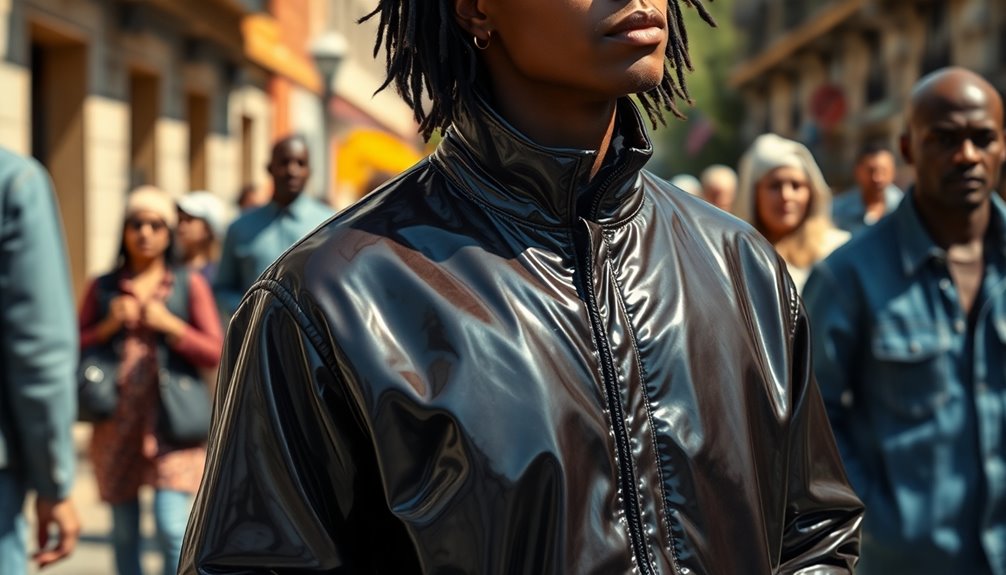
When considering materials for streetwear, oil fabric stands out due to its unique blend of style and functionality.
Oilskin offers exceptional water resistance, making it a practical choice for unpredictable weather, unlike cotton fabric, which is breathable but less protective.
While traditional fabrics like denim and corduroy require special care, oilskin is easy to maintain with just a simple wipe down.
It's also more durable, with a heavier weight ranging from 169gsm to 470gsm, ensuring longevity.
Additionally, oilskin's glossy finish and unique texture allow for stylish designs that catch the eye.
Unlike itchy wool, oilskin can be easily reproofed with wax treatments, restoring its protective qualities and extending the lifespan of your favorite streetwear pieces.
Styling Tips for Incorporating Oil Fabric Into Your Wardrobe
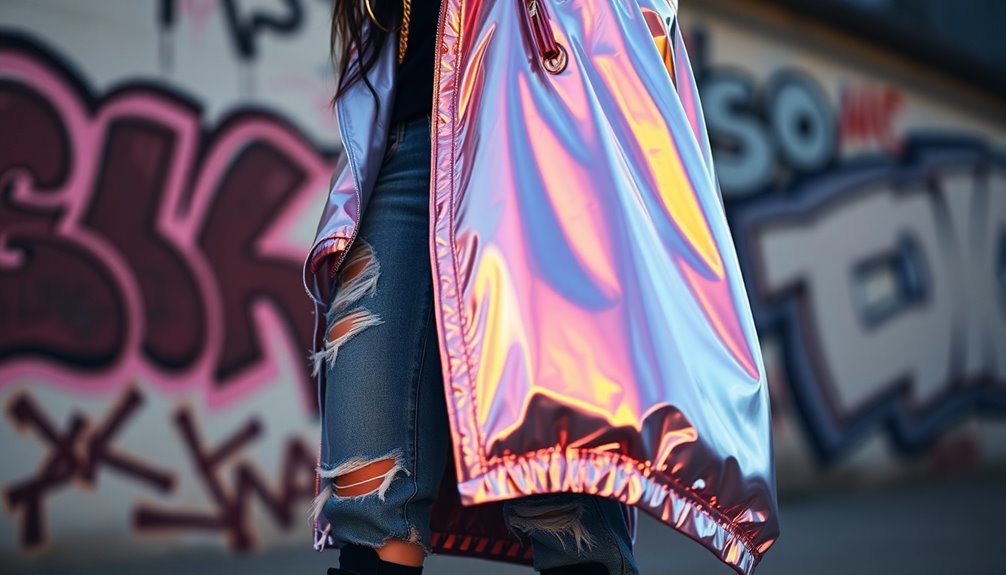
Incorporating oil fabric into your wardrobe can elevate your streetwear game while providing practical benefits. Here are some styling tips to help you get started:
- Layer Smartly: Pair oil fabric pieces, like an oilskin jacket, over breathable fabrics such as cotton or jersey to stay comfortable and protected from the elements.
- Mix Textures: Combine an oilskin trench with a soft cotton hoodie for a visually interesting look that maintains both comfort and style.
- Accessorize Wisely: Opt for trendy accessories made from oil fabric, like bucket hats or bags, to enhance your outfit without overpowering it; they add durability and waterproofing.
The Future of Oil Fabric in Streetwear
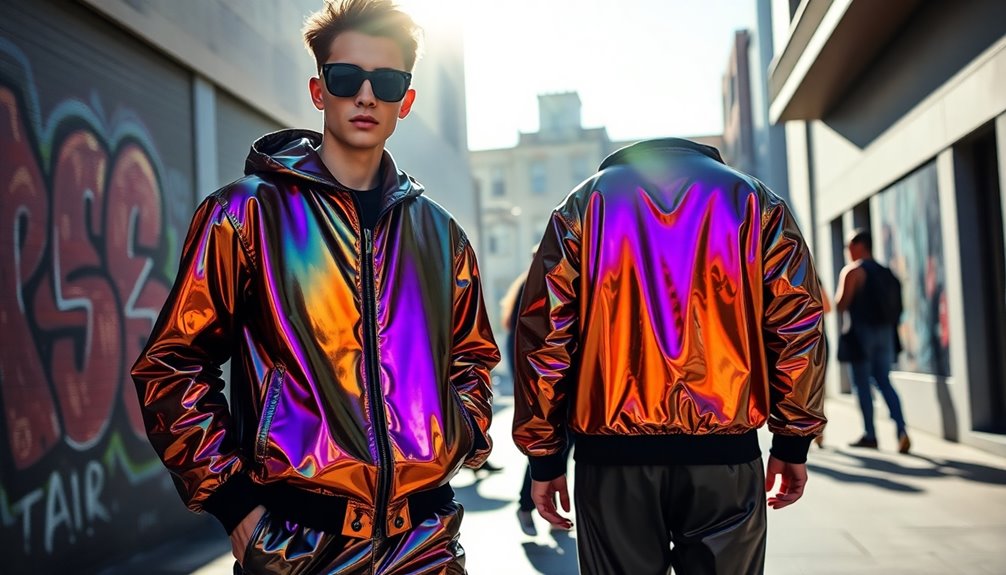
As you look to the future of streetwear, oil fabric's sustainability and eco-friendliness are likely to play a key role in your choices.
With its versatility in design, you can expect innovative styles that not only protect against the elements but also make a bold fashion statement.
Embracing these developments will keep your wardrobe fresh and aligned with evolving consumer values.
Sustainability and Eco-Friendliness
While many streetwear brands chase trends that often compromise sustainability, oil fabric emerges as a game-changer. This innovative material not only offers durability and water resistance but also aligns with eco-friendly principles that resonate with you as an environmentally conscious consumer.
Here are three key points to evaluate:
- Natural Materials: Oil fabric is often made from organic cotton, minimizing the use of harmful chemicals found in synthetic fabrics.
- Longevity: Its durability and reproofing capabilities mean you can maintain and reuse pieces, reducing waste in the fashion industry.
- Conscious Choices: By choosing oil fabric, you support brands committed to sustainable practices, appealing to a growing market of eco-friendly consumers.
This shift towards sustainability helps redefine streetwear for the better. Additionally, this material's durability and reproofing capabilities can help reduce waste in the fashion industry by promoting long-lasting clothing options.
Versatility in Design
Oil fabric stands out in streetwear design, offering an impressive blend of style and functionality.
Its versatility allows you to incorporate it into a variety of pieces, from jackets and hats to bags, making it perfect for any outfit.
Thanks to its water-resistant properties, you can confidently wear these stylish designs in unpredictable weather without sacrificing aesthetics.
With advancements in production, oil fabric now comes in a vast array of colors and textures, enabling unique streetwear collections that catch the eye.
Plus, its lightweight yet durable nature guarantees comfort and ease of movement, which is essential for an active lifestyle.
As sustainability gains importance, oil fabric can also be reproofed, extending its lifespan while appealing to eco-conscious consumers. Additionally, the trend of using advanced filtration systems in textile production emphasizes the growing demand for innovative materials in fashion.
Where to Buy Oil Fabric Clothing and Accessories

Looking for the perfect oil fabric clothing and accessories? You're in luck! This unique texture has become a popular choice for stylish streetwear.
Here are three great places to find oil fabric items:
- Patagonia – Known for high-quality jackets and bags, combining function with style.
- ASOS – An e-commerce platform that showcases trendy oil fabric designs, perfect for streetwear enthusiasts.
- Thrift Stores – Don't overlook vintage shops for one-of-a-kind oil fabric pieces that promote sustainable fashion.
When you shop, check customer reviews and product descriptions to verify you're getting clothing with ideal water resistance and durability.
With these options, you'll easily find oil fabric items that elevate your wardrobe!
Frequently Asked Questions
What Is Another Name for Oil Cloth?
Another name for oil cloth is "oilskin."
You'll often hear this term used when discussing its application in waterproof clothing and outdoor gear. Oilskin is a more modern version of oil cloth, blending traditional oil treatments with contemporary materials to enhance durability and flexibility.
Both materials are known for their vibrant colors and exceptional water resistance, making them popular choices for various fashion and home decor items.
What Fabric Is Used in Streetwear?
When you think of streetwear, imagine a canvas where comfort meets style.
Fabrics like cotton, denim, nylon, polyester, and leather play key roles in creating that edgy look.
Cotton's softness is perfect for laid-back vibes, while denim adds durability and classic flair.
Nylon and polyester keep things lightweight and practical, ideal for your active lifestyle.
Leather, with its bold aesthetic, brings an unmistakable edge.
Each fabric tells a story, shaping your unique streetwear identity.
What Is Oilskin Fabric Made Of?
Oilskin fabric's made from tightly woven cotton, treated with oils and waxes to make it water-repellent.
You'll find that multiple layers of oils and resins are applied, solidifying during a curing phase for enhanced durability.
While it originally used linseed oil, modern variations may include synthetic materials for better performance and color options.
This fabric usually has a smooth, slightly glossy texture, making it versatile for both fashion and outdoor gear.
Which Cloth Material Is in Trend?
Right now, oilskin fabric is definitely in trend.
You'll love how its blend of durability and water resistance makes it perfect for unpredictable weather. The vintage aesthetic is back, giving you plenty of stylish options that go beyond traditional outerwear.
Plus, oilskin is easy to clean and reproof, making it a practical choice for your streetwear collection. Fashion brands are embracing it, so you can find unique pieces that fit your style effortlessly.
Conclusion
Incorporating oil fabric into your wardrobe is like adding a splash of vibrant color to a black-and-white canvas; it transforms your style and makes a statement. As streetwear continues to evolve, oil fabric stands out with its unique blend of durability and flair. Just like the unexpected twist in a favorite song, this trendy material brings fresh energy to your outfits. So, don't hesitate—embrace oil fabric and let your style sing!
